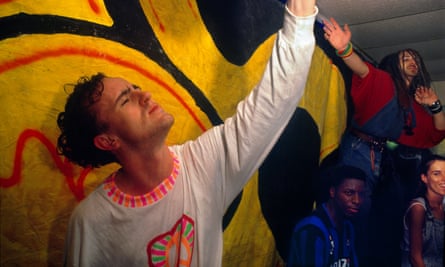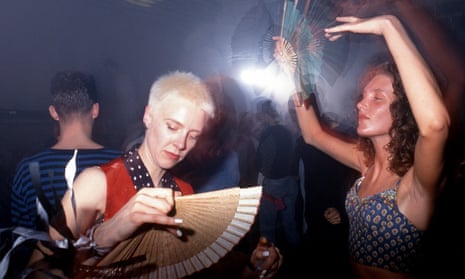Danny Rampling, founder and DJ
The mid-80s was a depressed period for youth culture. People were waiting for something to happen. In August 1987, I joined Paul Oakenfold, Nicky Holloway and Johnny Walker for Paul’s birthday week in Ibiza. We went to Amnesia, an open-air club that got going around four in the morning, and it was a revelation: a melting pot of people dancing to a wildly eclectic mix, from pop, rock, reggae and film scores to house, techno and acid. It was totally intoxicating, the Balearic sound, and it inspired us. I decided to start my own club night, to sprinkle a bit of that Ibiza magic in London.
I started Shoom in the Fitness Centre, a gym on Southwark Street. The West End had The Wag Club and Le Beat Route but they closed at 3am. The Fitness Centre said we could open till five. Because it was a gym, there was a wall of mirrors. So many people walked into them headfirst, including myself.
We filled the room with apple and cherry flavoured smoke and decorated it with painted banners: smiley face logos and slogans. It was a free state of hedonism. A proportion of the crowd adopted this baggy look because it was hot and they were dancing non-stop until five. Colourful self-made T-shirts, dungarees, Kickers and Converse. It became the look of the rave scene as a whole.
It was a very broad mix of people. Patrick Cox used to come along, and Paul Rutherford from Frankie Goes to Hollywood. Boy George loved it and was inspired to make more acid house-type records. Martin Fry from ABC. Kevin Rowland. Genesis P-Orridge.
The Fitness Centre didn’t really want to be promoting alcohol, but there wasn’t much drunk in the club anyway. What they did have was Lucozade, which became the drink of choice because it helped you cool down in the heat. We’d also pass around trays of fruit to help rehydrate people.
The whole thing wasn’t just based on drugs, that’s a misconception. Yes, there was a revolutionary new music, acid house, and with that came a stimulant, ecstasy. They kind of went hand in hand and it was a very positive, profound experience for a lot of people. But for me, primarily, it was about the music.
Shoom was more than just a club. It was a way of life. The Fitness Centre only held 300 people, so strong friendships were formed there. People used to bring gifts for each other. I’d end my set with Joyce Sims’ Come Into My Life or William Pitt’s City Lights or even The Art of Noise’s Crusoe. People would leave very blissed out and I’d go to the front door and say goodbye to everyone.

Pete Heller, DJ
My sister dragged me down to Shoom. After queuing for ages we descended into the madness. You couldn’t see much because of the smoke and the strobes. There was a real mix: gay, straight, black, white, pop stars, suburban kids, young hippyish types with baggy T-shirts and long hair. It was a real change: the club scene in London was quite poseurish. Suddenly you were in this mad environment full of people going crazy and hugging each other. It was very druggy and very intense, a completely new vibe.
Clubs in the mid-80s could be quite rough, full of idiots who liked drinking and violence. But there was none of that. They insisted on an open-minded, positive, friendly vibe. If you didn’t have that, you weren’t coming in. It was quite a commitment. It wasn’t somewhere you could sit down comfortably in the corner. Shoom was a sweatbox.
One night these American tourists showed up, very smartly dressed. I think they were expecting it to be like Studio 54. Someone obviously gave them a pill because they were there all night, completely trashed. They were probably never the same again. It wasn’t just ecstasy, there was quite a lot of acid at the beginning, so it was quite a psychedelic happening. You did feel like you were part of this new hippy revolution.
When Shoom reopened at Busby’s, in Charing Cross Road, Danny asked me to be the warm-up DJ. That was my big break. I played a lot of disco, funk and downtempo stuff – Vince Montana’s Heavy Vibes, Jimmy “Bo” Horne’s Spank, even Soul II Soul’s Keep on Moving. I occasionally played over records with my guitar, so I got roped into the first Boy’s Own Recordings release, which was Raise by Bocca Juniors. And that was the genesis of my music career.
We were there at ground zero when dance music exploded out across the globe. Within a couple of years, every town had its own house music club and the baggy look came to define youth culture. Shoom changed the whole mentality behind going out. You’d come out of the club with that feeling: “Ah, it’s incredible, people can just get along.”

Comments (…)
Sign in or create your Guardian account to join the discussion